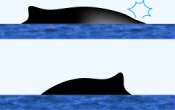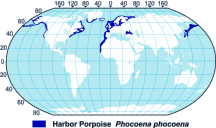ORDER: Cetacea
SUBORDER: Odontoceti
FAMILY: Phocoenidae
GENUS: Phocoena
SPECIES: phocoena

One of the smallest of the oceanic cetaceans, the harbor porpoise is shy and elusive, not inclined to approach boats and bow ride, as many other species of dolphins and porpoises do. On calm days these animals can be easily detected by the loud puffing sound they make as they surface to breathe. Because of its inshore habitat, it is one of the best-studied small cetaceans, and also one of the most frequently hunted.
Physical Description
The body of the harbor porpoise is small in size, but rotund and stocky through the mid-section, tapering to a slender tailstock. Its snout is blunt and rounded without a prominent beak. Its mouth is small and tilts upward, and contains 22 to 28 small, spade shaped teeth on each side of the upper jaw and 22 to 26 on each side of the lower jaw.

Surface Characteristics
Color
Its back is very dark gray or dark brown, shading to a lighter gray patch on the sides; its belly is white. Its flippers are also dark in color, and a dark stripe extends from the flipper to the eye.
Fins and Fluke
Flippers are small, rounded at the tips, and oval in shape. The dorsal fin is broad based, low, and triangular and is located slightly aft of the center of the body. Sometimes a series of small nodules are found on the leading edge of the dorsal fin. Its flukes are small and curved with a definite median notch.
Length and Weight
Maximum length is 6 feet (1.9 m) with a possible maximum weight of 200 pounds (90 kg). Most harbor porpoises are much smaller, and do not exceed 5 feet (1.5 m) or weigh more then 130 pounds (60 kg). The females are slightly larger than the males.
Feeding
The harbor porpoise eats non-spiny fishes such as herring, cod, whiting, squid, pollock, and sardines. It seems to require large amounts of food, consuming approximately 10% of its body weight each day.
Mating and Breeding
Sexual maturity is believed to be at 3 to 4 years. Calves are 27 to 35 inches at birth (70 to 90 cm) and weigh 14 to 22 pounds (6.4 to 10 kg). Gestation period is about 11 months, and the calving interval is usually every 2 years. Calves may nurse for about 8 months.

Range Map
Distribution and Migration
This is an inshore species inhabiting shallow, coastal waters. Harbor porpoises are normally found in the North Atlantic, North Pacific, and Black Sea in temperate and subarctic waters of less than 60 degrees F (15 degrees C). This little porpoise may often be found in bays and sometimes moves into large rivers.
Natural History
Harbor porpoises may be seen singly or in pairs, or in small groups of 6 to 10 animals. Sightings have been reported of 50 to 100 in groups that were actively feeding. This species tends to strand frequently, possibly because it lives so close to shore. Some live stranded porpoises have been taken to aquariums, but few have survived in captivity.
Status
Because of its near shore habitat, the harbor porpoise has been hunted for centuries. Though still locally abundant, they are not as numerous as they once were-natives take substantial numbers off Greenland for food and oil. They become entangled in salmon and cod nets in the eastern North Atlantic; in the Pacific they are caught in trawl and gill nets; their numbers were severely depleted in the Black and Baltic Seas by drive fisheries and netting. Pesticides, destruction of habitat by coastal development, and boat traffic may all be responsible for the decline of most populations of harbor porpoises.
Bibliography
- Bjørge, A. and G.P. Donovan (Eds.). 1995. Biology of the Phocoenids. IWC, special issue 16.
- Jefferson, T.A., M.A. Webber, R.L. Pitman. 2015. Marine Mammals of the World: A Comprehensive Guide to their Identification, 2nd edition. Elsevier/AP.
- Leatherwood, S., R. Reeves, W. Perrin and W. Evans Whales, Dolphins and Porpoises of the Eastern North Pacific and Adjacent Arctic Waters. U.S. Dept. of Commerce: NOAA Technical Report. NMFS Circular 444, July 1982
- Read, A.J., P.R. Wiepkema, P.E. Nachtigall. 1997. The Biology of the Harbour Porpoise. De Spil.
Acknowledgements
illustrations courtesy Uko Gorter, copyright ©2017 all rights reserved.
FACT SHEETS MAY BE REPRINTED FOR EDUCATIONAL OR SCIENTIFIC PURPOSES